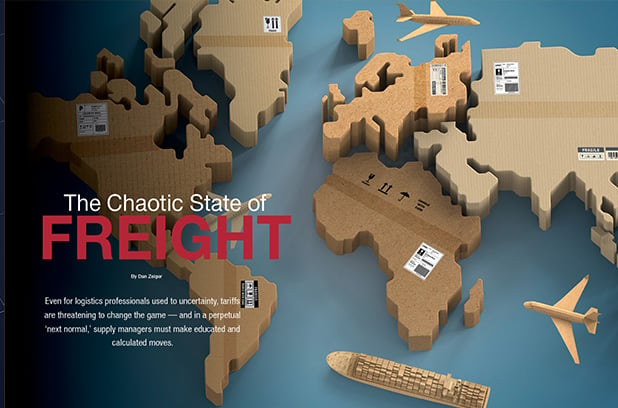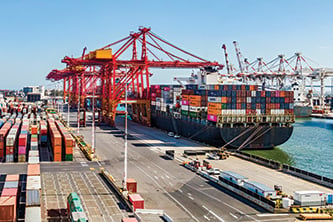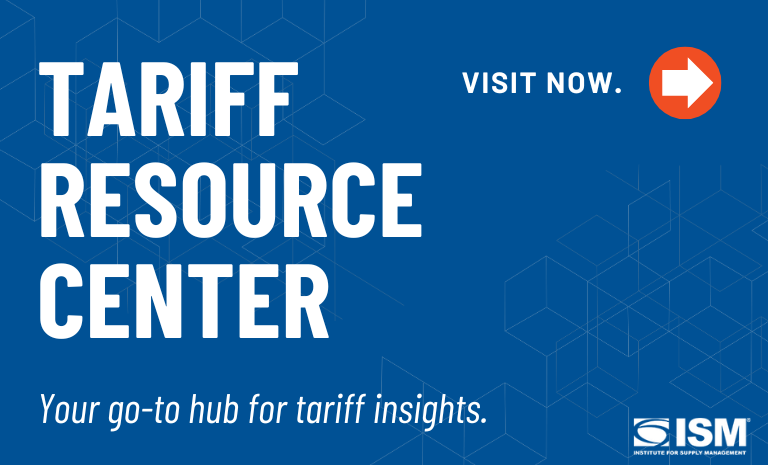The Chaotic State of Freight
Even for logistics professionals used to uncertainty, tariffs are threatening to change the game — and in a perpetual ‘next normal,’ supply managers must make educated and calculated moves.

For the global freight industry, navigating the last decade’s challenges has felt like a madcap game of Risk, with carriers and customers trying to position pieces on the map while the board sits on a vibrating table.
Among the factors creating turbulence: climate events of higher frequency and intensity, tariffs and a trade war, COVID-19 engulfing the globe, the Suez Canal blockage, persistent inflation, sluggish demand, and geopolitical tensions in the Red Sea and elsewhere. And in recent months, even more tariffs uncertainty.
Despite the less-than-ideal playing conditions, Keith Andrey, MBA, never shies from judiciously grabbing the dice or drawing a card — not to gamble, but to take an educated risk. The president of North America freight forwarding at UPS Supply Chain Solutions needs no reminders of the insanity, as he encounters it almost every day. However, Andrey says, it fosters innovative solutions.
“For me, this environment is chaotic — but in a way, it’s also intriguing and exciting, especially for logistics professionals,” he says. “Instead of just fine-tuning processes, we’re making real changes on behalf of customers. We’re actively creating results to help them stay competitive in the market. So, as crazy as it sounds, I’m actually kind of enjoying it. It’s disruptive, yes, and very unpredictable. But it’s also energizing.”
Not everyone in the freight industry shares Andrey’s outlook, but they do agree the environment is hectic.
“Things have just been coming left, right and center, paralyzing shippers and carriers in terms of how best to respond,” says Peter Sand, chief analyst at Xeneta, the Oslo, Norway-based digital freight platform. “When you disrupt something like this, there’s a price.”
While it’s too soon to tell if global shipping is headed for realignment, the industry, having weathered a prolonged recession, is well-versed in volatility and uncertainty — which, Sand says, might be to its advantage.
Changing Conditions Limit Certainty
For perspective on the level of volatility in the industry and how quickly freight fortunes can change, consider two recent headlines about Lowell, Arkansas-based J.B. Hunt Transport Services. In February, the London Stock Exchange Group published a report, “Is the Freight Recession Finally Over? J.B. Hunt Thinks So,” detailing the company’s positive outlook following its 2024 fourth-quarter (Q4) report.
That optimism was short-lived, as J.B. Hunt’s Q1 data revealed sluggish trucking demand and an 8-percent year-over-year decrease in operating income. Shares in the company slid based on the news, which was captured under a Business Insider headline: “The U.S. Freight Recession is Showing No Signs of Relenting.”
On an earnings call, J.B. Hunt CEO Shelley Simpson said, “I’ve never seen a recession last three years. I think everyone’s holding on. It is a very difficult environment that we’re operating in, and I think everyone’s trying to adapt to it.”
Tariffs have only added to the indigestion. As Inside Supply Management® went to press, the Trump administration hinted at walk-backs or imminent trade agreements with some countries. However, significant duties — the 10 percent “baseline,” those on products from Mexico and Canada, those on steel and aluminum and the astronomical levies on Chinese imports — remained, with major supply chain implications.

Demand for such domestic transportation services as trucking would get a boost from nearshoring and reshoring, but ocean freight will still command a big share of the market because of its cost effectiveness.
Anxiety among executives and such departments as finance is normal, Andrey says: “Their job is to present a steady forecast and a clear outlook to stakeholders. With tariffs flipping on and off, it becomes incredibly difficult for them to predict anything with certainty.” But veteran supply managers have been through this before, he says, and they’ve shown the ability to help businesses grow even amid highly protectionist trade policies.
In fact, companies can apply playbooks from two events — the 2018 trade war and coronavirus pandemic — during the first Trump administration. COVID-19 built “muscle” in supply chains, Andrey says, making them nimbler in the wake of disruptions, including by sourcing from alternate locations.
However, with tariffs enacted to the recent global degree, it’s a bigger challenge. “Every customer’s value point for their product is different, which influences what they do,” Andrey says. “There are also products that cannot be easily sourced elsewhere, and so in those conditions, the consumer will most likely pay an increase based on the tariff.
“It’s on (carriers) to be quick in providing information allows customers to make good decisions. With the size of our customer base, it’s hard to say one size fits all.”
Sand says the 2017-21 playbook is applicable only to an extent, in part because actions by manufacturers, shippers and carriers to get around trade obstructions during the first Trump administration have created more complex supply chains. He cited the “China plus one” approach that has helped make such countries as Vietnam a bigger sourcing presence.
“American imports have grown dramatically from Vietnam, but also from Canada and Mexico, who were already big trading partners with the U.S.,” he says. “That was the next normal. Supply chains adjusted to it, only to see trade barriers put up against imports from Canada and Mexico.
“Under conditions like this, there will always be a next normal. Not a new normal that gets fixed — a next normal.”
Signs of Slowing Demand
In ocean freight, the biggest factor on rates and carrier finances has been the turmoil in the Red Sea that began in November 2023. Due to Houthi rebel attacks on vessels, major container shipping lines have generally avoided that route — which includes the Suez Canal — resulting in longer sailing distances, tighter markets and better carrier profitability, despite declines in spot rates for most routes.
For example, Xeneta’s market average shipping index for a 40-foot equivalent unit (FEU) container from East Asia to the U.S. West Coast hit a 12-month high of US$7,911 in July, dropped to $3,994 in mid-December, rebounded to $5,729 in early January and settled at $2,723 on April 23.
The X-factor, as has been the case for years, is demand. “That’s what scares most people right now,” Sand says. “If American consumers start holding back and demand really starts to fall off, importers start running down inventory, which means less ocean freight.”
The tariffs impact was likely manifested in ports data in April. The Port of Los Angeles processed more than 2.5 million 20-foot equivalent units (TEUs) in the first quarter, a year-over-year increase of 5.2 percent. But for the week ending May 10, the number of freight vessels leaving China and headed to the port was down 15 percent compared to the previous week and 34 percent year over year, according to tracking system Port Optimizer. In TEUs, the protection was 72,941 for the week ending May 10, down from 120,589 two weeks earlier.
Plummeting demand would be, Sand says, “tricky” for carriers, but they have stopped previous bleeding by artificially reducing capacity through blanked (or cancelled) sailings. According to shipping consultancies, carriers cut their weekly baseline projected sailing capacities by 28 percent for cargo from East Asia to the U.S. West Coast in late April, and 42 percent for cargo from Asia-East Coast routes in mid-May.
In airfreight, Xeneta reported that volumes climbed 11 percent and average spot rates were up 15 percent year over year in December. In 2025, demand is projected to grow 4 percent to 6 percent, but the industry’s “cautious optimism remains tempered by its susceptibility to geopolitical tensions, a subdued manufacturing outlook and political interventions in an increasingly volatile world,” Xeneta chief airfreight officer Niall van de Wouw said in a press release.
A potential political intervention is the Trump administration’s aggressive policy on immigration (see feature article on page 26), which has led to fears of an American tourism slump if foreign visitors rethink travel to the U.S.
Andrey notes passenger traffic trends, which impact availability of belly freight, the cargo that travels in the lower hold of an airliner. “If passenger numbers drop, airlines will pull wide-body aircraft from the network,” he says. “When that belly capacity goes away, we have to shift more product to freight aircraft, which changes both availability and cost.”

(Y)ou need a plan A, B, C, D and E. You can’t just do what you did last year or the year before, because not everything in that playbook will work. Supply chain organizations need to be ready, be flexible, and above all, manage risk.”
— PETER SAND
Xeneta
Larger Carriers Provide More Flexibility
Ocean freight figures to be impacted by companies reducing their reliance on China and moving manufacturing and sourcing operations closer to the U.S. Andrey notes that while demand for such domestic transportation services as trucking, rail and airfreight would get a boost from nearshoring and reshoring, ocean freight will still command a big share of the market because of its cost effectiveness compared to airfreight.
That has been especially true in recent months, as companies made larger orders to get ahead of tariffs. “Ocean freight is going to do reasonably well in the long term,” Andrey says. “From a cost perspective, it’s the most efficient transportation system in the world.”
He continues, “If companies continue to move away from traditional JIT (just-in-time) and store inventory for longer periods of time, that’s conducive to taking advantage of the cost per unit of ocean freight. That solution allows customers to hopefully claw back a portion of the cost increase related to the tariff.”
What else should supply managers know? Not surprisingly, Andrey touts the size and flexibility of the shipping network of a company like UPS. Sand concurs: Larger carriers and forwarders are likely “better equipped to handle complex demands in today’s world,” he says, “while smaller players may have to go more niche to survive.”
With a network of more than 90 U.S. airports and trucking services that can deliver cargo anywhere in the continental U.S. within four days, UPS enables customers to choose speed or savings, Andrey says. “We can offer ‘X’ as the best solution, or ‘Y’ as a cheaper solution,” he says. “And here’s the savings for adding a day to the transit.”
The current environment, Sand says, offers supply management organizations the opportunity to heighten skills learned during previous mega-disruptions.
“You really need to understand the business you rely on,” he says. “I’m not saying everyone needs to be a full-time market analyst, but you can’t just take a surface-level view anymore. Risk management has become a core skill for supply chain professionals. You’ve got to be ready to deal with unexpected costs. Sure, you may not like a higher price tag, but that’s still better than your cargo not moving at all because you didn’t have a plan.”
Extra Points
Among the other issues impacting global freight:
Infrastructure. Andrey emphasized investments in railways, airports and especially port dredging. “I’m a big fan of dredging ports deeper to get bigger vessels into more ports,” he says. “Many smaller ports can’t handle large vessels. Investing in these areas could diversify demand and reduce congestion at major ports like Long Angeles and Long Beach.”
Decarbonization progress in ocean freight has been slow, Sand says, as some carriers have retreated from decarbonization efforts due to a lack of investment in renewable fuel production by the petroleum industry. “The broader infrastructure isn’t there yet,” he says, but regulators could provide a bigger push.
Labor. In recent years, there has been conflicting sentiment regarding the severity of truck driver and pilot shortages, which have been likely mitigated somewhat by the freight recession. Andrey says that while attracting and retaining workers is less of an issue for a large company like UPS, it remains a challenge for the freight industry as a whole.
***
“At the end of the day, this is still a people business,” Sand says. “You can have large ships carrying tens of thousands of containers, but it all comes down to relationships. Supply managers must trust logistics providers to deliver the solutions they need.
“Most importantly, you need a plan A, B, C, D and E. You can’t just do what you did last year or the year before, because not everything in that playbook will work. Supply chain organizations need to be ready, be flexible, and above all, manage risk.”


